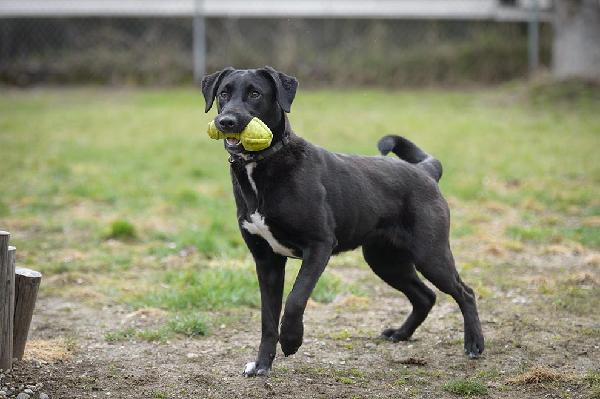When training or handling animals, the BC SPCA advocates the use of force-free, humane training techniques utilizing evidence-based learning theories which foster trust and build positive human-animal relationships.
The BC SPCA is opposed to training methods or devices which employ coercion and force. Aversive, punishment-based techniques may alter behaviour, but the methods fail to address the underlying cause and, in the case of unwanted behaviour, can lead to undue anxiety, fear, distress, pain or injury.
Approved by the Board of Directors – July 2016
(replaces Positive Reinforcement Training, October 2004)
Background
Behaviour research on animal training techniques supports a force-free methodology. Humane (force-free) training is defined as training or caring for an animal without using pain, fear, or physical or verbal intimidation techniques. Animals learn best when training follows the American Veterinary Society of Animal Behaviour’s recommendations: “focus on reinforcing desired behaviours [positive reinforcement], removing the reinforcer for inappropriate behaviours, and addressing the emotional state and environmental conditions driving the undesirable behaviour.”
The BC SPCA does not support the use of devices and techniques that cause anxiety, fear, distress, pain or injury, such as choke chains, prong and shock collars (dogs); action devices and performance packages (horse soring); and bullhooks (elephants).
For dogs, studies indicate that humane training techniques are more effective than punishment-based approaches with the benefits that dogs are more likely to perform well in novel tasks, to be more playful, and to interact more positively with strangers.
Research also indicates that over the long term, dogs trained through punishment may develop a fear response to the handler, less bonding with the guardian, less playful behaviour, less inclination to engage positively with strangers and show an increase in fear-associated behaviours, including aggression. Humane dog training is an inherently safer methodology for both animals and people.
When working with any animal, preventing behaviour issues is the first approach that should be undertaken. In the case of companion animals, this includes understanding animal learning theory, knowing the critical socialization periods of an animal’s development and recognizing animal emotional states. This also includes facilitating realistic guardian expectations based on an animal’s unique temperament and the issues of concern.
“Dominance theory” to explain problem behaviours in dogs has recently re-gained public popularity. This is an incorrect and harmful concept when applied to human-animal relationships. Traditional dominance theory training uses force and intimidation as a way to assert “pack leader” or “alpha dog” status over dogs to control their behaviour. Tools and techniques used may include restricting movement, striking (hitting or pinching), pinning down or kneeling on animals; the use of physically or verbally harsh corrections on animals; and the aggressive use of choke chains, prong collars or devices that shock animals (collars, fencing, prods, etc.). Some trainers and guardians who do not necessarily subscribe to dominance theory based training may still use these inappropriate aversive training techniques when working with dogs, horses, cats and other animals.
These techniques cause anxiety, fear, distress and, in some cases, pain or injury. Because fear and anxiety are often the underlying causes of behaviour problems in companion animals, these techniques often make the behaviour issue even worse.
Background updated – July 2016
References
American Veterinary Society of Animal Behavior 2008 AVSAB Position Statement: The Use of Dominance Theory in Behavior Modification of Animals.
American Veterinary Society of Animal Behavior 2007 AVSAB Position Statement: The Use of Punishment for Behavior Modification in Animals.
Blackwell EJ, Bolster C, Richards G, Loftus BA and Casey RA 2012 The use of electronic collars for training domestic dogs: estimated prevalence, reasons and risk factors for use, and owner perceived success as compared to other training methods. BMC Veterinary Research 8: 93
Deldalle S and Gaunet F 2014 Effects of 2 training methods on stress-related behaviors of the dog (Canis familiaris) and on the dog-owner relationship. Journal of Veterinary Behavior 9: 58-65
Rooney N and Cowan S 2011 Training methods and owner-dog interactions: Links with dog behaviour and learning ability. Applied Animal Behaviour Science 132: 169-177
Schilder MBH and van der Borg JAM 2004 Training dogs with the help of the shock collar: short and long term behavioural effects. Applied Animal Behaviour Science 85: 319-334
Definitions
Dominance: A relationship between individual animals that is established by force/aggression and submission to determine who has priority access to multiple resources such as food, preferred resting spots and mates.
Force-free training: See humane training.
Humane training: Training or caring for an animal without using pain, fear, physical or verbal intimidation techniques.
Positive reinforcement: Adding something the animal wants which increases the likelihood the behaviour will reoccur. For example, a treat or other reward is given to a dog when he fetches his ball, which builds his desire to want to continue to fetch.





